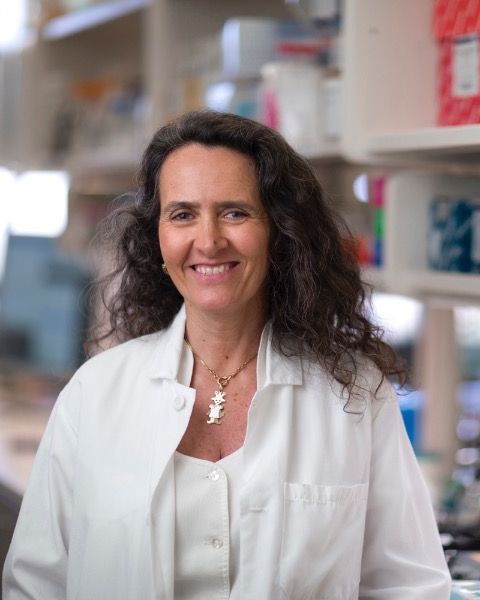Myeloma Genomics and cell signaling
Poster Session 3
P-337: The germinal center origin and progression of MM is captured by 83 Vk*MYC MM transplantable lines that share overlapping genomic diversity with human disease
Friday, September 29, 2023
1:15 PM - 2:15 PM EEST

Marta Chesi, PhD (she/her/hers)
Associate Professor
Mayo Clinic Arizona
Scottsdale, Arizona, United States
Introduction: Multiple myeloma (MM) originates from a B cell undergoing B-cell receptor affinity maturation in the germinal center. Errors during class switch recombination and ectopic somatic hypermutation generate immunoglobulin (Ig) gene translocations that are presumptive originating events present in the earliest stages of plasma cell neoplasia. Secondary somatic mutations, including MYC rearrangements, NFkB and RAS/mTORC1 pathway activation, contribute to tumor progression and subclonal heterogeneity. Here, we explore the multi-step progression occurring spontaneously in a murine model of MM driven by MYC dysregulation.
Methods: We performed WGS, WES and RNAseq on 15 de novo, 58 transplantable lines and 25 tumor lines capable of growth in vitro. In established Vk*MYC transplantable lines, the transgene was excised by tamoxifen driven CRE recombinase.
Results: We confirmed that MYC expression is sufficient to initiate the progression of a benign monoclonal gammopathy, but full malignancy requires additional somatic events that are spontaneously acquired and selected over time in tumors that have undergone significant Ig somatic hypermutation (average 4.6 mutation/100bp). Notably, there is a convergence between mice and men in the signaling pathways dysregulated during tumor progression, although the genomic mechanisms can be species specific. As in human MM, we noted activation of the NFkB pathway in half of the tumors mostly driven by structural rearrangements in Map3k14, including insertional mutagenesis by endogenous retroelements. This is consistent with a key role for NFkB pathway in MM progression, as demonstrated in two recent murine models of MM driven by IKK2 activation. While activation of RAS/MTORC1 in human MM is mostly driven by mutations of N- and K-RAS, unique to the mouse is the complete inactivation of Pten in a third of cases due to deletion and point mutations mediated by a transcription linked mutational process with a preference for thymidine. As in human MM, we detected frequent alteration (one third) of chromatin modifiers, most commonly Kdm6a and Ncor1. Like in human MM, Trp53 inactivation is almost universal in tumors capable of growing in vitro. Similar to human MM, we noted a progressive reduction of Ig transcription with disease progression, ranging from >50% of the transcriptome in early stages to ~1% in cell lines growing in vitro, that inversely correlates with proliferation. Despite the acquisition of these various progression events, the tumors remain dependent of continuous MYC transgene expression, identifying tumor specific vulnerability.
Conclusions: By forcing progression of monoclonal gammopathy through MYC dysregulation, the Vk*MYC model spontaneously acquires a diverse array of mutations associated with progression in human MM. This genomic diversity is captured in 58 transplantable tumors lines that can be passaged in vivo into immunocompetent non-irradiated, syngeneic C57Bl/6 recipients, and 25 cell lines capable of in vitro growth.
Methods: We performed WGS, WES and RNAseq on 15 de novo, 58 transplantable lines and 25 tumor lines capable of growth in vitro. In established Vk*MYC transplantable lines, the transgene was excised by tamoxifen driven CRE recombinase.
Results: We confirmed that MYC expression is sufficient to initiate the progression of a benign monoclonal gammopathy, but full malignancy requires additional somatic events that are spontaneously acquired and selected over time in tumors that have undergone significant Ig somatic hypermutation (average 4.6 mutation/100bp). Notably, there is a convergence between mice and men in the signaling pathways dysregulated during tumor progression, although the genomic mechanisms can be species specific. As in human MM, we noted activation of the NFkB pathway in half of the tumors mostly driven by structural rearrangements in Map3k14, including insertional mutagenesis by endogenous retroelements. This is consistent with a key role for NFkB pathway in MM progression, as demonstrated in two recent murine models of MM driven by IKK2 activation. While activation of RAS/MTORC1 in human MM is mostly driven by mutations of N- and K-RAS, unique to the mouse is the complete inactivation of Pten in a third of cases due to deletion and point mutations mediated by a transcription linked mutational process with a preference for thymidine. As in human MM, we detected frequent alteration (one third) of chromatin modifiers, most commonly Kdm6a and Ncor1. Like in human MM, Trp53 inactivation is almost universal in tumors capable of growing in vitro. Similar to human MM, we noted a progressive reduction of Ig transcription with disease progression, ranging from >50% of the transcriptome in early stages to ~1% in cell lines growing in vitro, that inversely correlates with proliferation. Despite the acquisition of these various progression events, the tumors remain dependent of continuous MYC transgene expression, identifying tumor specific vulnerability.
Conclusions: By forcing progression of monoclonal gammopathy through MYC dysregulation, the Vk*MYC model spontaneously acquires a diverse array of mutations associated with progression in human MM. This genomic diversity is captured in 58 transplantable tumors lines that can be passaged in vivo into immunocompetent non-irradiated, syngeneic C57Bl/6 recipients, and 25 cell lines capable of in vitro growth.
